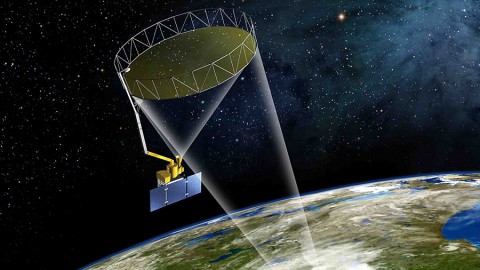Written by Alan Buis
NASA’s Jet Propulsion Laboratory
 Pasadena, CA – The launch of NASA’s Soil Moisture Active Passive (SMAP) mission at Vandenberg Air Force Base (VAFB) in California is scheduled for Thursday, January 29th. Liftoff from Space Launch Complex 2 aboard a United Launch Alliance Delta II rocket is targeted for 6:20:42am PST (9:20:42am EST) at the opening of a three-minute launch window.
Pasadena, CA – The launch of NASA’s Soil Moisture Active Passive (SMAP) mission at Vandenberg Air Force Base (VAFB) in California is scheduled for Thursday, January 29th. Liftoff from Space Launch Complex 2 aboard a United Launch Alliance Delta II rocket is targeted for 6:20:42am PST (9:20:42am EST) at the opening of a three-minute launch window.
If needed, a backup launch opportunity is available on the Western Range on January 30th with the same launch window.
SMAP is the first U.S. Earth-observing satellite designed to collect global observations of surface soil moisture and its freeze/thaw state.

The mission will provide the most accurate and highest-resolution maps of soil moisture ever obtained, mapping the globe every two to three days from space for a least three years. The spacecraft’s final circular polar orbit will be 426 miles (685 kilometers) at an inclination of 98.1 degrees. The spacecraft will orbit Earth once every 98.5 minutes and will repeat the same ground track every eight days.
Prelaunch News Conference
Tuesday, January 27th: The prelaunch news conference will be held at 1:00pm PST (4:00pm EST) at Vandenberg Air Force Base. The briefing will be carried live on NASA Television and streamed on www.NASA.gov . The public can post questions during the briefings via Twitter by using the hashtag #askNASA. The event will also be streamed on www.ustream.tv/NASAJPL2
Participants in the prelaunch news conference will be:
- Christine Bonniksen, SMAP Program Executive
- NASA Headquarters
- Tim Dunn, NASA Launch Manager
- Kennedy Space Center, Florida
- Vernon Thorp, Program Manager, NASA Missions
- United Launch Alliance, Centennial, Colorado
- Kent Kellogg, SMAP Project Manager
- Jet Propulsion Laboratory, Pasadena, California
- Dara Entekhabi, SMAP Science Team Leader
- Massachusetts Institute of Technology, Cambridge, Massachusetts
- 1st Lt. John Martin, Launch Weather Officer, 30th Operations Support Squadron
- Vandenberg Air Force Base, California
Cubesat Science Building
An ELaNa CubeSat briefing will be held immediately following the prelaunch news conference. NASA will launch three small research satellites for two universities and JPL. More than 100 university students have been involved in the design, development and construction of the CubeSats that are being flown as auxiliary payloads on the SMAP mission.
Presenting the mission science objectives for the ELaNa CubeSats will be:
- Scott Higginbotham, NASA ELaNa-X Mission Manager
- Kennedy Space Center, Florida
- Dave Klumpar, Firebird-II Principal Investigator
- Director, Space Science and Engineering Laboratory
- Montana State University, Bozeman, Montana
- Jordi Puig-Sauri, EXOCUBE Principal Investigator
- California Polytechnic State University, San Luis Obispo, California
- David Rider, GRIFEX Principal Investigator
- JPL
SMAP Social Media Event
As part of the event, on January 28th, a speaker program about the science and engineering of SMAP will be broadcast at 9:30am PST (12:30pm EST) on NASA Television and webcast at:
- http://www.nasa.gov/nasatv
- http://www.ustream.tv/nasajpl2
Launch Day Viewing
Post Launch News Conference
Weather and visibility conditions permitting, the launch may be visible from the Greater Los Angeles area by looking to the west.
For photographers: the launch azimuth after liftoff will be 196 degrees.
Following launch, SMAP observatory and mission officials will hold a postlaunch news conference to provide the spacecraft status and discuss its state of health, as well as the status of the ELaNa CubeSats. The event will begin at 9:00am PST (noon EST) and will be carried live on NASA Television and www.ustream.tv/NASAJPL2
NASA Television Coverage
NASA Television will carry the prelaunch news conference starting at 1:00pm PST (4:00pm EST) on Tuesday, January 27th. The prelaunch news conference also will be webcast at:
- http://www.nasa.gov/nasatv
- http://www.ustream.tv/nasajpl2
On launch day, January 29th, NASA TV launch commentary coverage of the countdown will begin at 4:00am PST (7:00am EST). Launch is targeted for 6:20:42am PST (9:20:42am EST). The launch window is three minutes in duration. Spacecraft separation from the rocket occurs 56 minutes, 52 seconds after launch.
The post-launch news conference also will be covered on NASA Television starting at 9:00am PST (noon EST).
For information on receiving NASA TV, go to:
http://www.nasa.gov/multimedia/nasatv/index.html
NASA Web Prelaunch and Launch Coverage
For extensive prelaunch, countdown and launch day coverage of the liftoff of SMAP aboard the Delta II rocket, go to:
- http://blogs.nasa.gov/smap
A prelaunch webcast for the SMAP mission will be streamed on NASA’s website at noon PST (3:00pm EST) on Wednesday, January 28th. To view the webcast and the countdown blog or to learn more about the SMAP mission, visit:
- http://www.nasa.gov/smap
- http://smap.jpl.nasa.gov/
Social Media
Join the conversation online and follow the SMAP mission on Twitter at:
- https://twitter.com/NASASMAP
Throughout the launch countdown, the NASA Launch Services Program and NASA JPL Twitter and Facebook accounts will be continuously updated at:
- https://www.twitter.com/NASA_LSP
- https://twitter.com/NASAJPL
- https://www.facebook.com/NASALSP
- https://www.facebook.com/NASAJPL
- https://www.facebook.com/NASAKennedy
Live countdown coverage on NASA’s launch blog will begin at 4:00am PST
(7:00am EST). Coverage will feature real-time updates of countdown milestones, as well as streaming video clips highlighting launch preparations and liftoff.
JPL is responsible for SMAP project management, system engineering, mission operations and the ground data system. JPL also built the observatory and its radar instrument. The NASA Goddard Space Flight Center in Greenbelt, Maryland, is responsible for the SMAP radiometer instrument.
Both centers collaborate on science data processing and delivery. NASA’s Launch Services Program at the agency’s Kennedy Space Center in Florida provides launch management. United Launch Alliance of Centennial, Colorado, is NASA’s launch service provider of the Delta II rocket.


